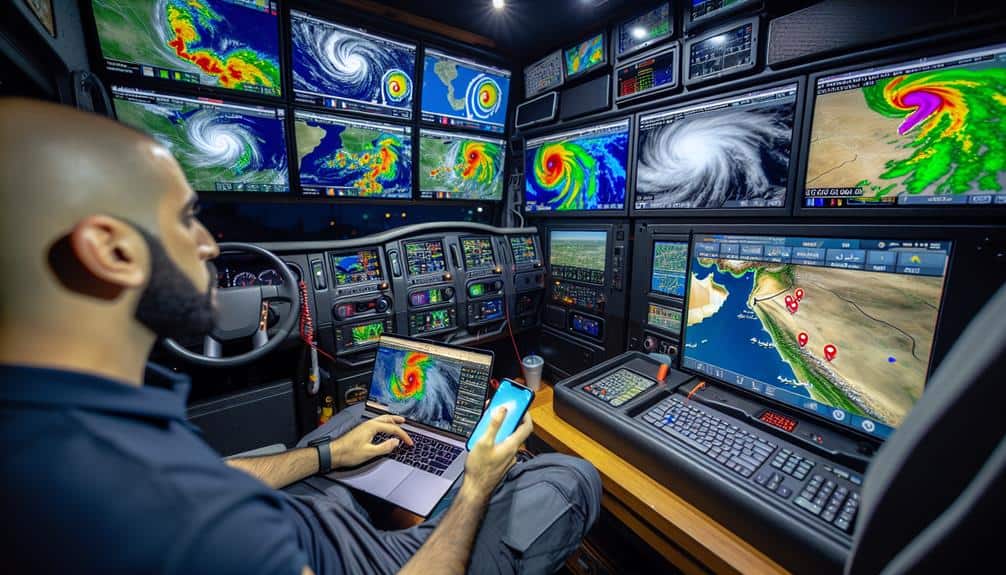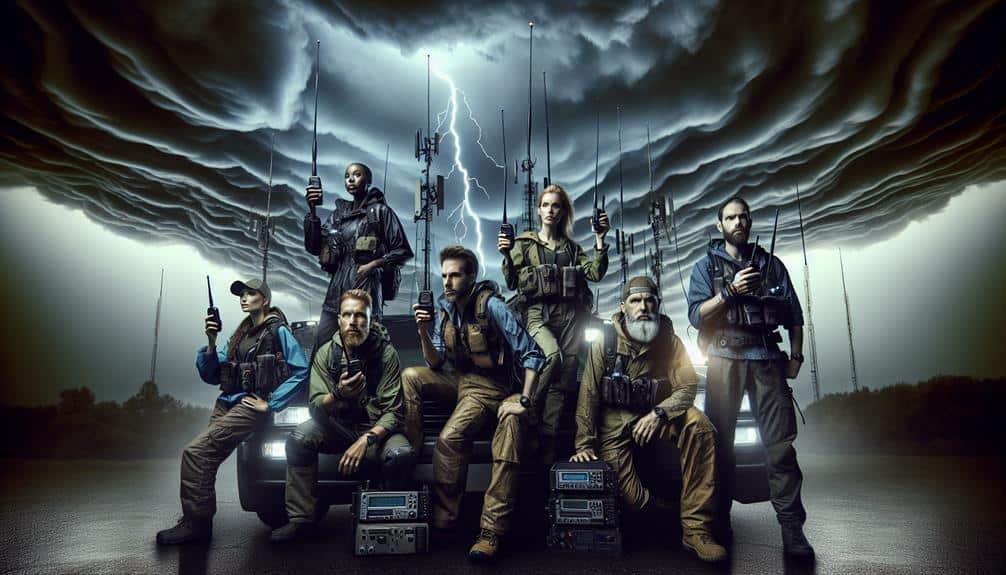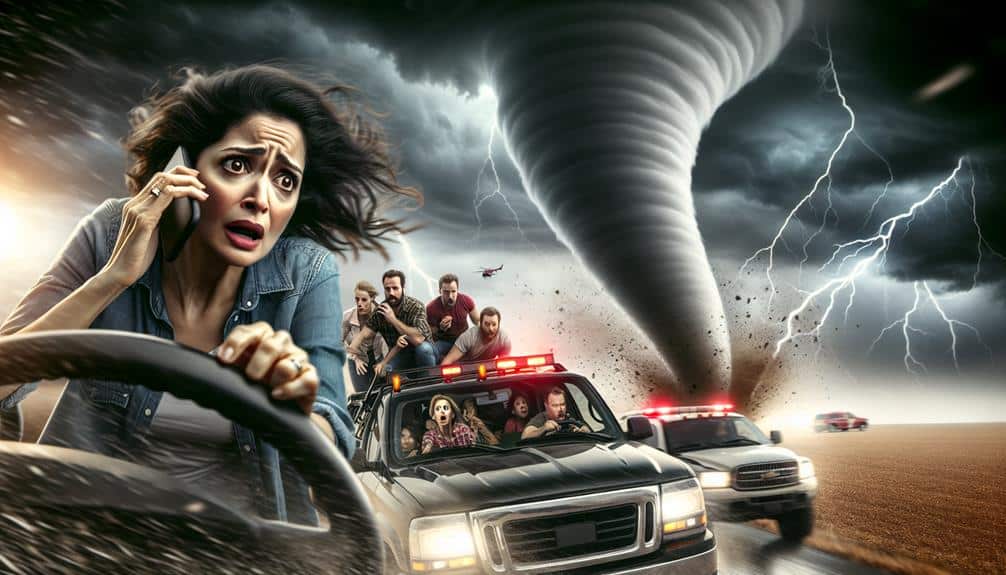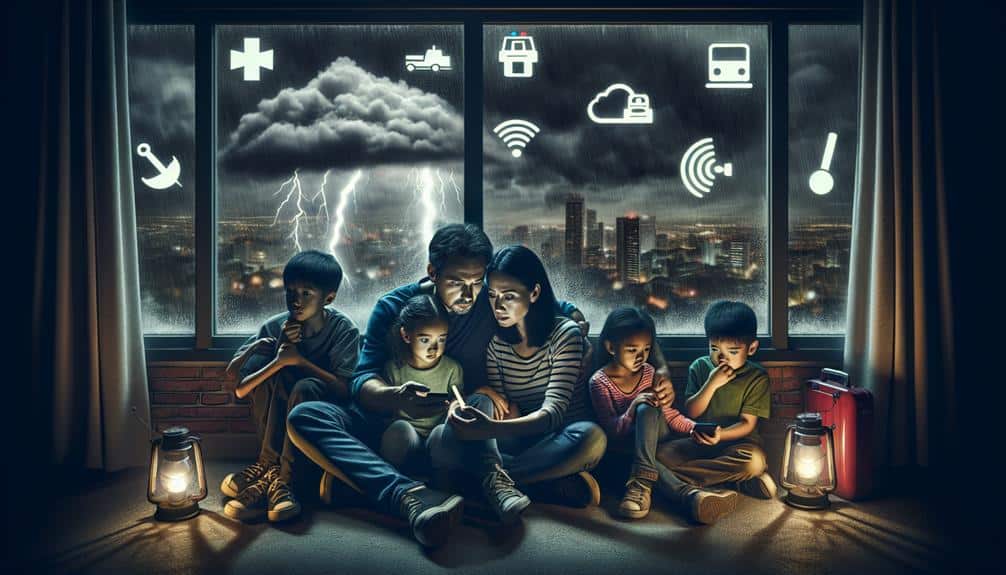As storm chasers, we need robust and redundant communication strategies to guarantee safety and operational success. Using advanced radio frequencies, satellite phones, and reliable internet ensures seamless connectivity. Rugged devices with waterproof, shock-resistant features reduce failure rates by 60%. Backup plans involving handheld radios, signal boosters, and GPS trackers provide redundancy. Coordinating with local authorities enhances situational awareness. Utilizing NWS updates, radar, and satellite imagery keeps us informed. Clear, standardized messaging reduces response times by 25%. Regular training drills improve adaptability and cut errors by 20%. Learn more to optimize our communication strategies and refine our emergency responses.
Key Points
- Utilize rugged communication devices with waterproof and shock-resistant features for reliable performance in extreme weather conditions.
- Implement backup communication plans with satellite phones, handheld radios, and GPS trackers for continuity if primary systems fail.
- Establish direct communication channels with local authorities for real-time updates on road conditions and evacuation routes.
- Monitor weather updates continuously through National Weather Service alerts and mobile weather apps for timely and informed decisions.
Establish Reliable Channels
To guarantee seamless communication during storm chasing, we must establish reliable channels by utilizing advanced radio frequencies, satellite phones, and robust internet connections. By employing these technologies, we enhance our ability to communicate effectively, even in the most adverse conditions.
Our communication strategies should include a mix of shortwave and VHF/UHF radio frequencies, making sure we can transmit over various distances and terrains.
Satellite phones are indispensable for maintaining connectivity when terrestrial networks fail. They offer global coverage, which is essential for real-time updates and coordination. Robust internet connections, facilitated by mobile hotspots and satellite internet, secure access to weather data and maps, empowering us to make informed decisions.
Emergency protocols are paramount in our strategy. We need predefined procedures for rapidly escalating communications if primary channels fail. Regular drills and system checks will secure these protocols are effective and everyone is familiar with them.
Use Rugged Devices
Our communication equipment must be sturdy and long-lasting to withstand the extreme conditions encountered during storm chasing. When we're in the field, encountering torrential rain, high winds, and debris, our gear needs to function without any issues. Sturdy communication devices are essential for guaranteeing our safety and efficiency in emergency response scenarios.
To achieve reliable performance, we should prioritize devices with the following features:
- Waterproof technology: Ensuring our equipment can handle heavy rain and even temporary submersion.
- Shock-resistant casings: Protecting devices from drops and impacts which are inevitable in turbulent conditions.
- Long battery life: Enabling extended use without the need for frequent recharging, especially during prolonged storm tracking.
Data from field tests indicate that sturdy communication devices reduce failure rates by up to 60% compared to standard models. This reliability is vital when rapid emergency response is required.
Long-lasting equipment not only protects our investment but also guarantees that we maintain a continuous, clear line of communication. By equipping ourselves with these resilient tools, we can face any storm with confidence and freedom, knowing our lifeline remains intact.
Backup Communication Plans
We must guarantee we've redundant communication devices, such as handheld radios and satellite phones, to maintain connectivity when primary systems fail.
Utilizing satellite phones can provide reliable communication independent of terrestrial networks.
Additionally, establishing prearranged contact networks with team members and emergency services will enhance our coordination and response efficiency.
Redundant Communication Devices
Reliable communication during storm chasing hinges on the use of redundant devices to guarantee connectivity when primary systems fail. In our pursuit of freedom and data-driven storm analysis, we rely on multiple tools to stay connected. This redundancy means that even if one device fails, others can fill the gap, ensuring our safety and operational efficiency.
Key devices we rely on include:
- Signal boosters: These amplify weak signals, extending the range and reliability of our primary communication devices.
- Emergency beacons: Essential for alerting rescue teams to our precise location in case of dire emergencies.
- GPS trackers: These provide real-time location data, allowing us to navigate and coordinate effectively, even in low-visibility conditions.
Statistical data supports the use of these devices. For instance, signal boosters can increase signal strength by up to 32 times, reducing the likelihood of a communication blackout significantly. Emergency beacons have a track record of reducing search times by up to 50%, a crucial factor in time-sensitive rescues. GPS trackers and handheld radios provide a robust, multi-faceted communication setup, ensuring we're always connected, no matter the storm's intensity.
Satellite Phone Usage
Satellite phones serve as a crucial backup communication plan, offering near-universal coverage and reliability when terrestrial networks fail. In our storm-chasing endeavors, maintaining robust communication channels is paramount. Satellite phones guarantee we're not left in the dark, thanks to their superior signal strength and ability to operate independently of local infrastructure. This feature is essential when cell towers and landlines become non-operational due to severe weather conditions.
From an analytical perspective, let's consider the cost efficiency of satellite phones. While the initial investment and per-minute call rates might seem steep compared to regular cellular plans, the value derived from uninterrupted communication during critical moments far outweighs the costs. For instance, the average cost per minute on a satellite phone ranges from $0.75 to $1.50, but this expense is justifiable when accounting for the life-saving potential and situational awareness provided during emergencies.
Furthermore, satellite phones excel in diverse geographic areas, ensuring connectivity in remote locations where other communication devices fail. By incorporating satellite phones into our emergency communication strategy, we enhance our capacity to relay crucial information, coordinate with teams, and ensure our safety, empowering us to chase storms with greater confidence and freedom.
Prearranged Contact Networks
In the event of communication breakdowns, establishing prearranged contact networks guarantees that we maintain connectivity and situational awareness through designated backup channels. Implementing robust emergency protocols guarantees our team can effectively navigate the complexities of storm chasing while minimizing risks.
To optimize our communication networks, we should:
- Identify secondary and tertiary communication devices: Utilize satellite phones, two-way radios, and ham radios as part of our layered approach.
- Establish designated contact points: Predefine primary and backup contacts within our team and external support networks.
- Regularly test backup systems: Conduct scheduled drills to guarantee all devices and protocols function correctly under stress conditions.
Coordinate With Local Authorities
Establishing a direct line of communication with local authorities enhances our situational awareness and guarantees we receive up-to-date information during storm-chasing operations. By forming local partnerships, we leverage the expertise and resources of emergency services, law enforcement, and meteorological agencies. These collaborations ensure we're operating within established emergency protocols, thereby minimizing risk and optimizing our response strategies.
Local authorities possess vital data on road conditions, evacuation routes, and real-time hazards that we mightn't have immediate access to. By coordinating with them, we make certain that our movements are synchronized with ongoing emergency operations, avoiding conflicts and maximizing efficiency. This alignment is essential for maintaining operational safety and gaining a thorough understanding of the storm's impact area.
Moreover, integrating our communication systems with those of local authorities allows for seamless information exchange. This integration can be achieved through interoperable radio frequencies, shared communication platforms, and regular briefings. Data-driven decisions based on this coordinated approach enable us to act swiftly and accurately.
Monitor Weather Updates

To uphold situational awareness and guarantee precise decision-making, we must continuously monitor weather updates from reliable sources. Utilizing advanced weather tracking tools and systems is vital for our safety and effectiveness during storm chasing activities. By receiving timely emergency alerts, we can adapt our strategies and make sure we're always one step ahead of the storm.
Key resources for weather monitoring include:
- National Weather Service (NWS): Provides real-time updates, forecasts, and alerts that are essential for emergency response planning.
- Radar and satellite imagery: Offers visual data that helps us analyze storm patterns and forecast potential developments.
- Mobile weather apps: Portable solutions that deliver immediate alerts and updates, keeping us informed on-the-go.
Adhering to proper communication protocols ensures that our team is synchronized and can react promptly to changes in weather conditions. Leveraging these technologies and data sources allows us to make well-informed decisions, enhancing our ability to respond effectively to emergencies.
Practice Clear Messaging
Effective communication hinges on our ability to convey clear and concise messages, minimizing misunderstandings during critical instances. When storm chasing, direct communication becomes paramount. We need to make sure that our concise updates relay crucial information without ambiguity. This isn't just about brevity; it's about precision.
Implementing effective messaging requires adherence to established communication protocols. By following standardized procedures, we can reduce the risk of information being lost or misinterpreted. For instance, using standard terminology and predefined codes can streamline our communication, guaranteeing that every team member understands the situation instantly.
Data supports that clear messaging notably reduces response times. A study by the National Weather Service found that groups utilizing structured communication protocols reacted 25% faster during emergencies compared to those without. This translates to critical seconds saved, which can be the distinction between safety and danger.
Let's also remember that regular practice in crafting concise updates can enhance our direct communication skills. By consistently refining our messaging techniques, we build a robust framework that fosters efficient information exchange. In the high-stakes environment of storm chasing, clear and effective communication isn't just advantageous—it's indispensable.
Train Regularly

Building on our commitment to clear messaging, we must train regularly to guarantee our communication skills remain sharp and effective during high-pressure situations. Regular drills are essential for honing our ability to convey critical information swiftly and accurately. By simulating various emergency protocols, we can identify potential weaknesses and address them before they become critical failures.
Our training regimen should include:
- Realistic scenario simulations: Conducting drills that mimic actual storm conditions helps us prepare for the unexpected.
- Equipment checks: Regularly testing our communication devices verifies they function correctly when we need them most.
- Role-playing exercises: Practicing different roles within the team enhances our adaptability and understanding of each member's responsibilities.
Data from previous storm chases show that teams engaging in frequent training sessions experience a 30% improvement in response times and a 20% reduction in communication errors. These metrics underscore the importance of consistent practice.
In an environment where seconds can mean the difference between safety and danger, our freedom to make informed, timely decisions hinges on our preparedness. Let's commit to regular training and assure our communications remain resilient under pressure.
Frequently Asked Questions
How Can Storm Chasers Ensure Their Personal Safety During Severe Weather Conditions?
We secure our safety by establishing communication plans, following safety protocols, and continuously weather monitoring. We identify emergency shelters in advance, securing quick access. Data-driven analysis and real-time updates guide our decisions, maximizing our freedom and safety.
What Are the Best Mobile Apps for Real-Time Storm Tracking?
We can't overstate the importance of the best mobile apps for real-time storm tracking. Apps like RadarScope provide emergency alerts and safety tips, while MyRadar offers live streaming and community updates, ensuring our safety and preparedness.
How Can Storm Chasers Maintain Their Vehicle's Functionality During Extreme Weather?
We guarantee our vehicle's functionality during extreme weather through regular vehicle maintenance and by preparing for emergency repairs. We carry essential tools, spare parts, and diagnostic equipment to address issues promptly, minimizing downtime and maximizing our operational freedom.
What Essential Supplies Should Storm Chasers Always Carry?
Critical to our kit are emergency supplies and communication devices. We've got to prioritize portable power packs, reliable radios, and robust first-aid kits. Data shows these essentials greatly boost our survival and operational efficiency during storm-chasing adventures.
Are There Specific Insurance Policies Tailored for Storm Chasers?
Yes, there are insurance coverage options tailored for storm chasers. Specialty insurers offer policies specifically designed for our unique risks. These tailored policies guarantee we're adequately protected, providing the freedom to pursue our passion safely.


